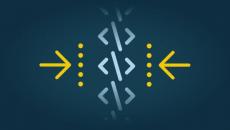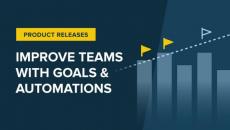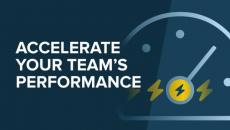|
By Don Brown
Don: The debate is over - how should you structure your software teams? That question is now answered in this year's State of DevOps report 2023. Other questions answered include: How does AI affect my company and team performance? How can we quantify the impact of culture on performance burnout? What even is culture in the first place? All these things are included in the State of DevOps report 2023. We have a very special guest, Eric Maxwell from the DORA group, to offer his takes on the report.
|
By Sleuth
Every team has a workflow, even if it’s chaotic or lacks consistency. It’s a no-brainer, though, that in the fast-paced world of software development, a clear and well-defined path to guide your work is essential to move efficiently. Workflows provide just that — the structure and framework that developers need to streamline their processes, collaborate effectively, and optimize productivity.
|
By Sleuth
If you want to make software engineering easy to improve, then automate actions in your development process. These simple yet high-impact “if this, then that” conditions pack a punch toward reducing toil and cognitive load. Your developers choose what’s important to improve and reap the benefits of an efficient and optimized development environment.
|
By Sleuth
Smart notifications and nudges are table stakes tools for developers looking to streamline their work and stay focused on building improvements. These automatic alerts are key to a more efficient workflow, freeing us from the burden of repetitive, overwhelming, and time critical tasks — aka, toil.
|
By Sleuth
Every team has guardrails, whether you recognize them or not. They’re a form of automation that can have significant impact on your software development process and the people doing the work. They’re another way to give toil the boot and keep developers in the flow. We’ve made the case for engineering automation in a previous article; here’s how guardrails as automations ensure that agreed upon boundaries and ways of working are codified into team processes.
|
By Sleuth
When you survey developers on how to improve engineering practices and their daily job experience, their answers invariably include getting rid of little annoying things - what's called toil. Toil is manual and repetitive tasks that waste your time. Toil is arguably worse than crisis, because a crisis is temporary and firefighting can feel rewarding when it's over. Toil is more like a death march - an insidious force that eventually leads to burnout.
|
By Sleuth
Sleuth's new Goals dashboard helps teams set, track, and achieve their goals. Here's how it works.
|
By Sleuth
We talk with numerous teams that want to improve their engineering performance. Here, we explain how to accelerate your progress using DORA metrics — a set of key performance indicators that can help you measure and optimize your team's software development process. You'll learn practical tips on how to leverage these metrics to achieve faster and more efficient team improvement. But first, you'll need your team to see the value in DORA metrics.
|
By Sleuth
We’ve all seen the news about tech layoffs. If you’re an engineering manager, are you having to squeeze more out of existing teams, because adding staff anytime soon is unlikely? Maybe you’re tempted to micromanage your developers, thinking that if you know every aspect of their work, it’ll boost productivity. But, that approach doesn’t feel right, and you know your devs would hate you for it. What’s an engineering manager to do?
|
By Alexandre Couëdelo
If you're a DevOps team looking for ways to improve your performance, you've probably heard of the Accelerate and DORA metrics. Tracking your performance with these metrics is a challenge, requiring good tooling. You might be tempted to build your own tracking solution, but you don’t need to! Due to the growing popularity of DORA metrics, several tracker tools are available on the market. But how do you choose the best DORA metrics tracker for you? This handy comparison guide will help!
|
By Sleuth
McKinsey's engineering productivity metrics...
|
By Sleuth
Don and Carl spar over what the perfect metric is for measuring engineering productivity - watch them take opposing sides to critically evaluate various contenders including lines of code , DORA metrics, SPACE metrics, cycle time, and more.
- February 2025 (7)
- January 2025 (7)
- December 2024 (13)
- October 2024 (1)
- December 2023 (2)
- November 2023 (9)
- October 2023 (8)
- September 2023 (3)
- August 2023 (9)
- July 2023 (6)
- June 2023 (7)
- May 2023 (3)
- April 2023 (10)
- March 2023 (6)
- February 2023 (8)
- January 2023 (3)
- November 2022 (2)
- October 2022 (3)
- September 2022 (9)
- August 2022 (7)
- July 2022 (3)
- May 2022 (3)
- March 2022 (1)
- December 2021 (3)
- November 2021 (2)
- October 2021 (4)
- September 2021 (1)
- August 2021 (3)
- July 2021 (6)
- June 2021 (1)
- May 2021 (1)
- April 2021 (7)
- March 2021 (5)
- February 2021 (3)
- January 2021 (2)
- December 2020 (3)
- November 2020 (4)
- October 2020 (4)
- September 2020 (4)
- August 2020 (11)
- July 2020 (5)
- June 2020 (3)
- May 2020 (2)
- April 2020 (1)
- March 2020 (2)
Deployment tracking, move fast without breaking things. When a deployment causes downtime, reduced performance, or customer facing bugs, Sleuth knows. Drawing from the best in class tools your engineering teams already use such as source control, APM, issue and error tracking. We equip your teams with the data needed to dramatically reduce downtime!
How Sleuth Deployment Tracking Works:
- Detect: When a deployment causes downtime, reduced performance, or bugs, our impact detection engine knows. Quickly identify, resolve, and re-deploy.
- Alert: Real-time Slack notifications fine-tuned to only the information you care about. Consolidate all your DevOps-related notifications into a single, powerful channel.
- Command: Track releases from staging to production. Know what's deployed, and what's coming. Understand the impact, and fix shit when it goes wrong.
- Control: Create order and eliminate release lag with PR-based workflows. Manage approvals, lock deployments, and ship with confidence.
Deploy Your Code With Confidence!





















